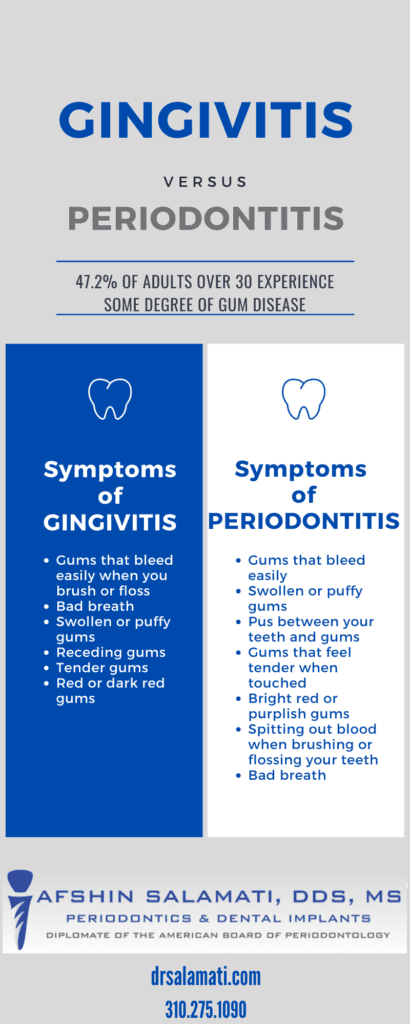What Is Gum Disease? Gingivitis vs. Periodontitis
3 Minute Read:
Gum disease (periodontal disease) is a common but unfortunate dental condition that affects millions of Americans. While these are many factors that cause this infection, it is most often the result of poor dental hygiene. When bacteria are not removed through proper brushing, flossing, and dental visits, they can build up and cause infections in the gums.
According to the CRC, nearly half of all Americans over the age of 30 suffer from some degree of gum disease.

There are two main variations of gum disease: gingivitis and periodontitis. While these are both forms of periodontal disease, they are different levels of that disease. The first stage is gingivitis, which, if left untreated, can lead to more severe periodontitis.
So, how does gingivitis develop, and what should be done to ensure it doesn’t worsen to become periodontitis.
What Is Gingivitis?
Gingivitis is a condition that causes red, bleeding, and inflamed gums. This mild infection is the first stage of periodontal disease and is completely reversible with conservative non-surgical treatments and improved oral hygiene.
Gingivitis develops when plaque builds up on the teeth and gums, creating a layer of bacteria.
The bacteria often form in hard-to-clean areas and irritate the gums, leading to inflammation.
As plaque is the leading cause of gingivitis, you can get rid of it by practicing good oral hygiene. Clean your teeth well twice a day and floss between your teeth. This will reduce the likelihood of gingivitis worsening and turning into periodontitis.
 How Can Gingivitis Develop Into Periodontitis Over Time?
How Can Gingivitis Develop Into Periodontitis Over Time?
While periodontitis has the same symptoms as gingivitis, it is a more advanced disease that results in loss of supporting bone around the teeth. This may require more advanced dental therapies.
As well as looking red and swollen, gums are likely to bleed regularly and may begin to recede. In later stages, the teeth can become loose, resulting in tooth loss.
The bacteria particles that cause gingivitis, when left undisturbed, results in hard calculus (tartar) formation around the teeth. In susceptible individuals, this results in further inflammation below the gum line and develops pockets between the teeth and gums as a result of the underlying bone loss around the teeth. If left untreated, these pockets can become deeper, causing teeth sensitivity and eventual tooth loss.
There are multiple types of periodontitis, including aggressive, chronic, and necrotizing.
What Should I Do if I Have Periodontitis?
If you are noticing any of the symptoms of gingivitis or periodontitis, schedule a consultation with your dentist / periodontist immediately. The sooner you start your periodontal treatment, the less invasive that treatment may be and the better the outcome.
Periodontal disease worsens with time.
The therapy used to treat your gum disease will depend on the stage your infection is in. Traditionally, gingivitis can be remedied with a deep cleaning and proper oral maintenance. More advanced stages of periodontitis require more thorough treatments, such as osseous surgery (pocket reduction therapy), guided bone regeneration, crown lengthening, and soft tissue grafts.
Non-surgical treatments may be appropriate in some cases of periodontal disease. These non-surgical therapies include scaling and root planing (to remove the bacteria), local delivery of antimicrobials, and systemic antibiotics.
Read Lola J.‘s review of Afshin Salamati, DDS, MS on Yelp
Contact Dr. Salamanti Today!
If you have any symptoms of gingivitis or periodontitis, don’t hesitate to reach out to Dr. Salamanti. Consultations are available for all types of teeth and gum issues. Contact the team today at (310) 275-1090.
